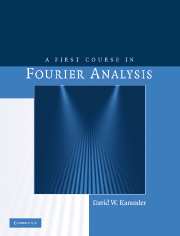Book contents
- Frontmatter
- Contents
- Preface
- 1 Fourier's representation for functions on, Tp, and ℙN
- 2 Convolution of functions on, Tp, and ℙN
- 3 The calculus for finding Fourier transforms of functions on ℝ
- 4 The calculus for finding Fourier transforms of functions on Tp, and ℙN
- 5 Operator identities associated with Fourier analysis
- 6 The fast Fourier transform
- 7 Generalized functions on ℝ
- 8 Sampling
- 9 Partial differential equations
- 10 Wavelets
- 11 Musical tones
- 12 Probability
- Appendices
- Index
5 - Operator identities associated with Fourier analysis
Published online by Cambridge University Press: 01 September 2010
- Frontmatter
- Contents
- Preface
- 1 Fourier's representation for functions on, Tp, and ℙN
- 2 Convolution of functions on, Tp, and ℙN
- 3 The calculus for finding Fourier transforms of functions on ℝ
- 4 The calculus for finding Fourier transforms of functions on Tp, and ℙN
- 5 Operator identities associated with Fourier analysis
- 6 The fast Fourier transform
- 7 Generalized functions on ℝ
- 8 Sampling
- 9 Partial differential equations
- 10 Wavelets
- 11 Musical tones
- 12 Probability
- Appendices
- Index
Summary
The concept of an operator identity
Introduction
In the preceding two chapters we developed a calculus for finding Fourier transforms of functions on ℝ, Tp, ℤ, and ℙN, and the corresponding rules are succinctly stated in Appendix 3. Each of these rules involves a pair of function-to-function mappings, i.e., a pair of operators. In this chapter we will study these operators and the elementary relations that link them to one another. The change in emphasis will enable us to characterize the symmetry properties associated with Fourier analysis, to deepen and unify our understanding of the transformation rules that we use so often in practice, and to facilitate our study of the related sine, cosine, Hartley, and Hilbert transforms. Later on, we will use operators to describe fast algorithms for computing the DFT, to describe fast algorithms for computing with wavelets, to analyze thin lens systems in optics, etc.
Operators applied to functions on ℙN
It is easy to illustrate these ideas when we work with functions defined on ℙN, i.e., with functions that can be identified with complex N-vectors. From linear algebra we know that any linear mappingA : ℂN → ℂN can be represented by an N × N matrix of complex coefficients. In particular, the discrete Fourier transform operator F defined by the analysis equation is a linear operator that is represented by the N × N complex matrix
The reflection operator R, defined by writing Rf[n] ≔ f[-n], n=0,±1,±2, …
Information
- Type
- Chapter
- Information
- A First Course in Fourier Analysis , pp. 239 - 290Publisher: Cambridge University PressPrint publication year: 2008
